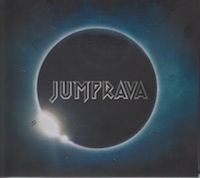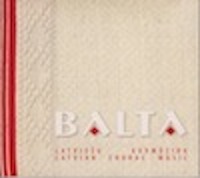Famed Latvian synth rock outfit Jumprava, who, having been performing off and on for 30 years, are one of Latvia’s most venerable groups. Though their zenith of popularity was in the early 1990s, they have been one of the most consistent ensembles throughout their decades of activity. Jumprava have stayed true to their electronic roots, and remain one of the most beloved Latvian bands of all time. Songs like ‘Ziemeļmeita’, ‘Tālu aizgāja’, ‘Vēlreiz’, among many others, earned them a place in the Latvian rock pantheon.
It has been a long hiatus for the band. Their last recorded output was Izredzētais, an album of music from the musical of the same name that was performed in Latvia in 2007. Their previous album of new material, Inkarmo, was released in 2005. Perhaps it is no surprise that the group has had limited activity in recent years – member Aigars Grauba has branched out into a very successful film career – directing some of the most popular Latvian movies in recent memory, such as Sapņu komanda 1935 and Rīgas sargi. However, in 2014, after this long silence, the group has returned with their latest album entitled Laiks runā.
Besides vocalist and instrumentalist Aigars Grauba, the group’s core members remain vocalist and guitarist Aigars Grāvers, as well as instrumentalists Ainārs Ašmanis and Aigars Krēsla.
Though the album itself is new, the group noted that many of the songs on the album are actually very old songs, but recorded for the first time. The band members listened to old concert recordings and ‘resurrected’ some of these songs and gave them a proper and modern treatment, as many had been unfairly forgotten.
The combination of both old and new material gives the album a sense of duality. Though certainly the synth rock style that Jumprava gained famed with is firmly rooted in the 1980s and early 1990s, Jumprava still are able to give their songs a fresh sound that never seems dated or even quaint.
The fire that Jumprava displayed in earlier songs like ‘Zem 2 karogiem’ and ‘Prom no pilsētas’ still burns brightly in songs like ‘Glāb’ (music by Grāvers, lyrics by Ritvars Dižkačs), where vocalist Grauba exhorts ‘Glāb mani – es sen vairs negribu būt kosmonauts‘ (Save me, I no longer want to be an astronout) over a thundering beat.
The song ‘Kareivis’ (music by Grāvers, lyrics by Jānis Baltauss), as its title (‘Soldier’) would imply, is in a similar vein, about a soldier dying in a battlefield, and, as time passes, new stems and new rye fields will grow, creating a new battlefield.
Jumprava have always balanced their driving and aggressive songs with more tender moments, and such a moment is on the song ‘Gaiss’ (music by Krēsla, lyrics by Rolands Ūdris), where Grāvers’ hypnotic vocals, repeating the phrase ‘nevar būt par daudz tevis’ (it is not possible to have too much of you) lulls the listener with the song’s dreamy atmosphere.
The decision to record songs that have been in the group’s repertoire for years, if not decades, give this album a sound that harkens back to their golden age of the early 1990s, and that, for many listeners, will make this record particularly enjoyable. Retaining their sense of melody, thoughtful lyrics, and even quirkiness that sustained their popularity for all these decades, Jumprava reestablish themselves as one of the premiere ensembles in Latvia today. Though they have gone for nearly a decade without recording new music, Laiks runā is an exceptional return to form, verifying that Jumprava remain at the top of their game and remain one of the undisputed cornerstones of Latvian rock music.
For further information, please visit Jumprava’s website.
Track listing:
- Sākums
- Saucējs
- Laiks teiks
- Neesmu varonis
- Glāb
- Kur sākums
- No rīta
- Gaiss
- Kareivis
- Māmiņ
- Ilgas
- Gaisma nāk
- Sapņu nesējs





